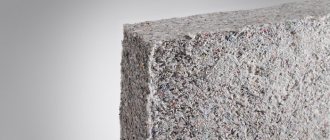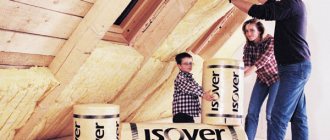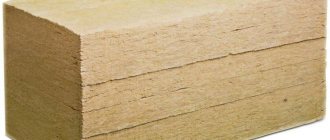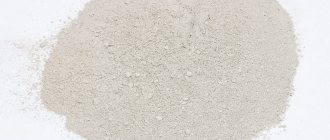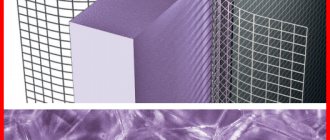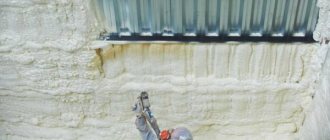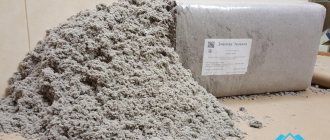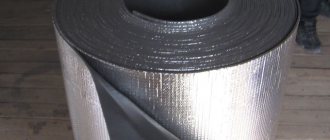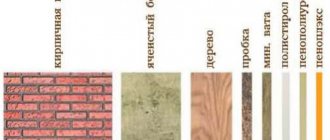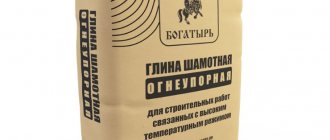Slowly, but Russians are still saying goodbye to small-sized apartments in Khrushchev-era buildings, where a 3-room apartment is often smaller in area than a modern one-room apartment. More and more large private houses are appearing. At the same time, we are talking not only about cottages in elite villages. As the living space increases, heating costs also increase. Proper thermal insulation of all structural elements of a building can save household finances, and therefore homeowners approach the choice of insulation very responsibly. After all, the slightest mistake is fraught with unpleasant consequences in the future.
Taking into account the increased attention of consumers to the topic of thermal insulation materials, the editors of the StroyGuru website have prepared a series of articles about modern types of insulation materials, their characteristics, advantages and disadvantages, and the best manufacturers. In this work we will tell you everything about polyurethane foam insulation, its liquid version, which among builders is called for short - polyurethane foam.
Definition
To better understand what polyurethane foam is, we will give a brief definition of the material - it is a synthetic foam with a cellular structure. Refers to a section of plastic filled with a special inert gas, and is often used in construction and manufacturing.
Among the undoubted advantages:
- • long-term use;
- • ease of operation;
- • minimal thermal conductivity;
- • excellent adhesion.
This is one of the high-quality insulation materials that is often used to improve the structural features of a house. Some surfaces are covered with gas-filled polyurethane foam of complex shapes. It has a long lifespan and is easy to use on construction sites.
How is it different from foam rubber?
Foam rubber is a type of elastic polyurethane foam.
The cellular porous structure provides good air, vapor and moisture permeability. The degree of elasticity is regulated by the addition of different types of polyol during production.
When choosing consumer goods, it is necessary to remember that “foam rubber” is the trade name of polyurethane foam , which was registered in the Soviet period by a Scandinavian company of the same name.
Foam rubber is mainly used in the light and furniture industries. Furniture upholstery, fillings for mattresses and pillows, soft toys, mannequins - this is a list of the most common uses of this type of polyurethane foam.
The material is characterized by different thicknesses and, accordingly, different rigidity. It is mainly produced in the form of sheets or blocks.
Different types of foam rubber are combined in the furniture industry, which improves the quality of the products.
For example, a more rigid sheet is used for a sofa seat than for the backrest.
Orthopedic products, as a rule, should not be soft. They are designed to ensure that the body is positioned correctly and comfortably. For this purpose, a new type of foam rubber with a “memory effect” was developed. It is able to return to its original shape after deformation. During operation, such material follows the contours of the body of the person lying on it, which allows you to relax as comfortably as possible.
The main mechanical characteristics of foam rubber, on which the service life of furniture products depends:
- rigidity;
- density;
- strength;
- elasticity;
- cell size;
- support coefficient.
For example, the support coefficient and cell size are decisive in highly elastic types of polyurethane foam.
Furniture foam rubber is subjected to significant loads, so conscientious manufacturers use the material with the highest density. It can easily withstand long-term dynamic loads and static weighting.
Polyurethane foam (PPU), composition and properties
It is obtained by mixing two liquid materials:
- • polyisocyanate;
- • polyol.
The substance is whipped, when it hardens, then 90% of the frozen result turns out to be gas. This way the foam can be used for thermal insulation. It stops letting cold and heat through. The final product is structurally different, and the area of use is also different. This depends on the proportion of liquids and additives used.
This is how foam rubber is created - an elastic and soft filler. It is usually used as an interior part for furniture: sofas, armchairs and other upholstered products. The brand depends on two indicators - how dense and hard the foam is.
Density and hardness table
| Brand | Hardness level | How much can you load kg/cm2 |
| ST | Standard. | from 60 to 101 |
| H.L. | Hard. | from 80 to 121 |
| H.S. | Soft. | From 60 to 121 |
| EL | Increased rigidity. | From 60 to 101 |
| HR | Highly elastic. | From 100 to 121 |
| CMHR | Fireproof and highly elastic. | From 100 to 121 |
The presence of a fire retardant impurity turns polyurethane foam into rigid polyurethane foam. It has an increased density - from 30 to 85 kg/cm3. When it is ready, it loses its elasticity. But it has many other useful properties:
- • used to reduce noise levels and thermal insulation;
- • for insulation from foundation moisture, if it is above 70 kg/cm3.
For construction purposes, polyurethane foam is prepared from a couple of components:
- • Isocyanate is the basis of the chemical process, an unchanged component.
- • Polyol – varies depending on the purpose.
Such elements affect the reaction rate, how much foam it will foam, what the density and flammability will be in the end.
GOST 307302-2006 confirms that polyurethane foam has a G3 class - what is it: it is considered fire-resistant, self-extinguishing and flame-retardant.
Application area
Liquid two-component polyurethane foam serves as an excellent insulation material for any structural elements of frame, brick, block and panel buildings, since its low weight does not create serious mechanical loads on house structures, including lightweight ones.
Good adhesion of polyurethane foam with all building materials allows you to spray insulation on vertical and inclined surfaces: facades, roofing, walls inside the house, ceiling. Excellent thermal insulation properties coupled with fairly high moisture resistance make this type of insulation attractive for thermal insulation of country houses, attics, balconies, floors (along joists). Low level of moisture absorption - foundation.
Attention: the use of the material under compressive loads reduces the thermal insulation effect to zero, and therefore polyurethane foam is not sprayed under the screed and “wet facade”.
Polyurethane foam insulation is also used in other industries. It is used to insulate freezers and is sprayed onto pipes of heating systems. Recently, in industrial construction they have begun to use ready-made sheet material for sandwich panels, when liquid polyurethane foam is poured into molds at the factory.
Varieties
Most enterprises can produce different types:
- • liquid – sold in spray containers;
- • hard – sheets, shells and panels;
- • foam rubber – mats and rolls of finished products.
Thickness and protective properties can vary depending on the purpose. The characteristics allow it to be prepared directly on the construction site. When the proportions of components change, the features change.
Foam rubber
It has a low density from 5 to 35 kg/m3. The scope of application is very wide - from furniture filler to linings in shoes and clothes, they are used to make washcloths and gaskets for doors and windows.
PPU hard
The main place of use is construction. More often it is produced directly on site - this saves resources. Using special equipment, workers mix the components in the required proportions.
This produces ready-made polyurethane foam, which is not afraid of petroleum products and water, but is afraid of organic solvents and other mineral acids. There are more than 30 brands of different purposes and densities. Polyurethane foam can be used in one form for insulation, or in combination with analogues of a different frequency.
The scope of application is wide - from noise and heat insulation of buildings to the insulating layer in refrigeration equipment. Extremely positive reviews.
Liquid
Used for spraying on walls and ceilings. Thanks to its thinner consistency, it became possible to spray it onto walls under pressure to provide insulation. Indispensable if you need to work without weighing down the structure.
Thickness table
| Name | Thickness, cm | ||||||
| 2,0 | 3,0 | 4,0 | 5,0 | 5,0 | 8,0 | 10,0 | |
| Uncoated/paper | 37,8 | 42,6 | 52,2 | 61,2 | 71,2 | 92,3 | 119,8 |
| Foil | 42,7 | 47,5 | 57,1 | 66,1 | 76,1 | 97,2 | 124,7 |
| Armofol | 37,5 | 41,2 | 49,3 | 56,8 | 65,0 | 82,6 | 105,5 |
| On one side - fiberglass | 51,6 | 56,4 | 66,0 | 59,8 | 68,0 | 85,6 | 108,5 |
Application technology
The most common method of polyurethane foam insulation is spraying onto the structural elements of the building.
PPU is sprayed onto the walls.
But there is another way - pouring, which requires a space closed on all sides. It is mainly used in factories producing sandwich panels.
Filling with polyurethane foam.
On the floor
Before spraying insulation on the base of the floor, preparatory work is carried out, including: removing the old screed, repairing the concrete base (in a wooden house the subfloor is being restored), waterproofing the ceiling or subfloor. The preparatory process is described in more detail in the material “Preparing the floor for pouring screed.”
A lathing for laminate, parquet, linoleum or joists for floorboards is mounted on the prepared surface. At the same time, both the sheathing slats and the joists should be 20-30 mm higher than the insulation. The gap is necessary to ensure ventilation.
On the walls
The technology for insulating the facade and walls from inside the room is the same. Consists of sequential operations:
- the old finish is removed from the surface of the walls (you can see how to quickly remove it in the work “Aligning walls for painting”);
- the sheathing is installed;
- polyurethane foam is sprayed. In this case, special attention must be paid to corners, crevices and voids;
- areas with protruding insulation are trimmed with a knife (easy to detect as a rule);
- Drywall is attached to the sheathing for finishing with wallpaper, painting or decorative plaster.
To the ceiling
Insulation of the PPU ceiling is carried out under a suspended or suspended ceiling. In this case, the old finish is removed from the surface of the floor slab, after which foam is applied in a thin layer (lathing is not required).
On the roof
The roof is one of the few places in the house where you can do polyurethane foam insulation work yourself. To do this, you need to buy special kits with 2 small cylinders and a sprayer. The containers contain the starting reagents, and a sprayer is needed to mix the components. But before starting work, you need to calculate the financial costs so that the roof does not literally turn out to be golden.
Semi-professional kit for PPU insulation.
Preparing the roof for insulation is simple: the surface is dust-free and dried. PPU is applied from the inside between the rafters. After the foam has hardened, the thermal insulation layer is covered with sheets of plywood or OSB.
PPU roof insulation scheme.
The editors of the portal StroyGuru.Com tried to objectively talk about such a controversial insulation material as polyurethane foam. Having complete information about the material, you can make an informed choice and avoid mistakes.
Polyurethane foam (PPU) technical characteristics and properties
In terms of thermal insulation characteristics, foam is superior to many analogues. As a heater it is difficult to find equal. High density and adhesion make the cold insulation capabilities even greater. They depend on the structure of the material. The liquid form has a coefficient of 0.019 to 0.035 W/m K, and the closest similar form, mineral wool, has a coefficient of 0.045 W/m K.
Vapor permeability is also low - closed cells do not let steam inside. For mineral wool, the same indicator is 50 times worse. Foam protects walls and ceilings from harmful influences, maintains the desired temperature inside the rooms and stops water particles from penetrating into the walls. But it is not recommended to use it under liquid or in direct contact with it, as this can cause a hydration reaction.
Comparison with mineral wool
This is the closest analogue, more popular, cheaper and inferior in a number of properties. The compressive strength of polyurethane foam is at the level of 0.3; for mineral wool it is not calculated, since it is a very flexible and obedient material.
Polyurethane foam can absorb no more than 10% of water; mineral wool is not designed for such a load and itself has a constant 4% humidity. It will not resist swelling from liquid, so it is not recommended to use it in residential buildings.
Let's talk about maximum service life. The foam will last at least 40 years, and the level of other substances does not exceed 10. Caked mineral wool simply becomes a harmful gasket that is of no use.
Polyurethane foam does not contain dangerous fumes, formaldehydes and phenols, like its cheaper analogue with 6% of unwanted compounds, and is completely safe. It is resistant to aggressive environments and has excellent resistance to rodents and insects. Polyurethane foam does not release fibers into the air; mineral wool contains an allergen for many people and azone-depleting gases.
Table: 12 characteristics
| Property | Index | Explanation |
| Density | 45-60 kg/m3. | Very light material, even mineral wool has 150-250. |
| Shrinkage | — | Was not identified. |
| Compressive strength | 0.46 mm/m. | An excellent indicator, foam concrete has a similar characteristic. |
| Heat conductivity | 0.021 W/m*K. | Mineral wool has 0.035 less than many analogues. |
| Frost resistance | Up to 1000 cycles. | Excellent feature. |
| Water absorption | 2%. | Better than analogues, foam concrete is up to 20%. |
| Vapor permeability | 0,001. | Almost complete insulation from steam, mineral wool has 0.29. |
| Fire resistance | 3G. | It goes out on its own and lights up poorly. |
| Price | 300-1800. | Depends on the thickness, presence and type of protective layers. |
| Sound isolation | High. | Higher than analogues. |
| Toxicity | Not considered toxic. | Can even be used in food refrigerators; there are no harmful fumes or dust. |
| How many years will it last | Up to 50. | It is considered one of the most durable types of insulation. |
Depending on the indicator they are divided:
- • C – self-damping;
- • Vehicles – difficult to burn;
- • TV – flame-resistant.
To increase fire resistance, special substances are usually added to the composition. It is important to know exactly which ones you can put, but it is better to entrust this to specialists rather than do it yourself.
Kinds
Experts distinguish three types of polyurethane foam:
Hard
This type of material has high density, hardness and lightness.
Thanks to these characteristics, it is used as acoustic or thermal insulation. Hard polyurethane foam looks like slabs. One of the applications is sandwich panels.
Beneficial features
Like any other material, foam has its advantages and disadvantages.
Advantages:
- • Lightness. Used in attics, roofs, light buildings. Doesn't make the structure heavy.
- • Does not require fastening elements or additional parts.
- • There are no “cold bridges”. Seamless thermal insulation.
- • Quick to apply. There is no need to prepare additionally or spend hours near the construction site.
- • You can work with the material at temperatures from -200 to +200 degrees.
- • Withstands changes in temperature and humidity, resistant to frost and heat.
- • Does not react to most alkalis, acids and salts.
- • Excellent surface grip.
In liquid form it is suitable for filling voids. Fills spaces between walls without dismantling ceilings - it simply pours into the hole.
Peculiarities
They are used very widely: rigid - as heat and sound insulation and lightweight form-building elements, elastic - as soft coverings and padding in everyday life and industry, as artificial sponges for washing and dust filters, material for paint rollers and inserts in garments, shock-absorbing package.
Self-foaming self-hardening compounds are popular for use directly on site in construction and mechanical engineering - both industrial multicomponent and household polyurethane foam.
Resistant to all common organic solvents, the frozen mixture can only be removed mechanically. In practical applications, protection from sunlight and other UV sources is required.
Compared to other foamed polymers used in limited areas - rigid polystyrene foam, elastic polyethylene foam, latex foam, microporous rubber, swelling cellulose sponge - the range of use of polyurethane foams is, as a rule, wider.
Minuses
Let's talk about what polyurethane foam looks like. It is a hardened foam with or without small pores, depending on the type of mixing. But it also has disadvantages:
- • Does not withstand constant exposure to ultraviolet radiation. It is necessary to protect from direct sunlight. The covering should be attached on top.
- • Apply only to dry and warm surfaces. Before application, the wall or floor should be cleaned of debris and rust to enhance adhesion.
Does not burn, but can smolder when exposed to high temperatures. Thermal insulation will deteriorate, so it is not recommended to use it in baths, saunas and stoves.
Review of manufacturers
Today, polyurethane foam is produced by many Russian and foreign companies. Among the market leaders are:
BASF
This brand was founded in Germany. Elastokam LLC became the official representative of the company in Russia. The product line includes spray-on, closed-cell, open-cell PU foam, casting systems, and materials for the formation of durable road surfaces. The company's product range includes polyurethane foam of any density. The price of liquid PU foam components of this brand ranges from 250 to 300 rubles per 1 kg.
Wanhua
Production is carried out in China. The company specializes in the production of liquid PU foam components. By mixing them, it is possible to obtain a high-quality sprayed heat-insulating material. 1 kg of components will cost 210-230 rubles.
Huntsman-NMG
Russian division of the international concern Huntsman. Since 1992, production has been carried out in the Russian Federation. The main product is sprayed polyurethane foam of various brands. The price for 1 kg of such material fluctuates around 250 -280 rubles.
Ecotermix
Russian manufacturer of components for sprayed polyurethane foam, as well as PIR and PUR filling systems. Closed-cell material of grade 300 and open-cell grade 600 are always available. The first is used for external work, and the second for internal work. Brand 300 polyurethane foam price – 160-170 rubles per 1 kg, brand 600 – 140-155 rubles.
ICYNENE
This Canadian-made polyurethane foam appeared on the Russian market relatively recently. Available in the form of separate components for the preparation of spray coating. Price for 1 kg – 180 -190 rubles.
Polymerization
Russian production company. Specializes in the production of shells, slabs, and shaped elements made of rigid polyurethane foam. Offers products of various thicknesses. 1 m2 of such coverage will cost approximately 2,500 rubles.
It is better to purchase polyurethane foam from trusted manufacturers that have a good reputation.
Before purchasing, the seller is asked to provide quality certificates and other accompanying documents for the goods. This is the only way to be sure of its quality and safety.
PPU material: what is it for health?
When the foam has hardened and is in the wall, it does no harm. But during the production process, all safety requirements must be observed. You cannot mix components without:
- •masks;
- • respirator;
- • protective suit.
Helpful Tips:
- • reagents must be tested and certified;
- • place – not blown;
- • equipment – high quality.
If all conditions are met, the foam will be safe.
Liquid insulation for walls: main characteristics
Polyurethane insulation is applied to the walls by spraying using special equipment. Therefore, most often such work is entrusted to specialists, but every homeowner can cope with this task independently, but subject to mandatory compliance with safety precautions and the use of special equipment and personal protective equipment.
In addition to spraying, which is performed mainly on vertical surfaces, the pouring method is sometimes used, but in this case only horizontal planes can be processed, and insulation can also be made by pouring it into pre-prepared molds.
Polyurethane is especially indispensable for insulating various voids, the insulation of which is practically impossible using traditional materials.
For example, often when installing window structures and doors, foam is used to insulate walls in cylinders , the application of which allows you to ideally seal the opening and protect the room from cold and noise.
How to install
One of the most common methods is spraying. Using this method, the material holds well and is used economically; it is suitable for structures with complex geometry, protrusions and recesses. For the process to be successful, you need to:
- • Make sure that the wall or other surface is dry.
- • No high humidity, rain, hail or snow.
- • The wind does not exceed weak 5 m/s, and it is better to protect the work area from it.
- • Make sure that the coating area is warm - not lower than +10 degrees.
- • Heat the mixture - about +18-25 degrees at the time of application; cold is difficult to work with and does not hold well.
- • Apply a layer of no more than 3-5 cm, if thicker is required - in 2-3 steps after drying.
The room must be ventilated. The person should wear a special suit, mask and respirator. Start with difficult areas: pipes, convex or concave parts, ventilation hatches or electrical distribution boxes.
Helpful Tips:
- • It is recommended to apply the composition in several layers. This way the effect will be more significant and adhesion will be higher. It is important to ensure that the previous layer is completely dry. Especially significant on walls with signs of destruction. Here it will lie unevenly and will require 2-3 additional sprayings to even out the area.
- • Before purchasing, you should consult with a specialist to choose the right brand of polyurethane foam with the required impermeability. This will save money and time spent on repairs. You can purchase high-quality, high-strength material.
- • If you apply polyurethane foam taking into account all the requirements and advice, then a coating will appear on the surface that will last for many years and will perform its tasks until the end of its service.
This material is used to insulate the foundation and external walls if necessary. It is also used to treat main pipes to retain heat in them. Mounted on balconies and loggias, used inside toys and sponges for washing dishes. This is a large part of production, which is involved in various fields. It’s easy to purchase, and it’s easy to apply. The result is of high quality and retains its beneficial properties for many years if handled correctly.
Installation methods
Spraying a thermal insulating coating made of polyurethane foam is a fast and high-quality installation method. To successfully spray thermal insulation you need:
- Dry, clean work surface;
- Lack of precipitation (rain, snow, fog);
- Wind no stronger than 5 m/sec;
- Working surface temperature from +10°C;
- Mixture temperature +18-25оС;
- The thickness of the sprayed layer is 3-5 cm.
The work is carried out in a protective suit and mask, in a ventilated room, starting with hard-to-reach areas (pipes, ventilation hatches, etc.). The sprayed layer in one pass is about 15 mm; for reliable insulation, the surface is treated several times.
The working process
Wall insulation with polyurethane foam can be carried out at temperatures above +10 degrees Celsius. The two-component composition in working condition is a homogeneous mass, which is under high pressure in the installation, heated to +45 degrees Celsius.
Equipment for spraying polyurethane foam Source legion-tehno.ru
Each of the two components enters the mixer in equal proportions. Otherwise:
- Exceeding the dose of polyisocyanate leads to destruction of the foam and loss of thermal resistance;
- if there is more polyol, the dry residue becomes brittle and thermal conductivity increases.
Spraying of polyurethane foam can only be carried out using a high-pressure unit. If the pressure is low, the coating will be uneven. This design has worse thermal insulation properties than expected.
A couple of reviews about EPPS
Leonid, 35 years old, Omsk: Used polystyrene foam to insulate the walls of a residential dacha. The house is small and heated in winter, so there were no problems with the appearance of moisture inside the insulating “pie”. I carry out repairs every 5-7 years, which means that during this time the insulation will not have time to sag and lose its qualities.
Vitaly, 45 years old, Khabarovsk: Expanded polystyrene does not weigh down the structure and retains heat well, so I chose this material. I heard that it is flammable, but the house uses a minimal amount of fire-hazardous coatings, for the most part concrete, brick, plastic, and metal are used everywhere.
